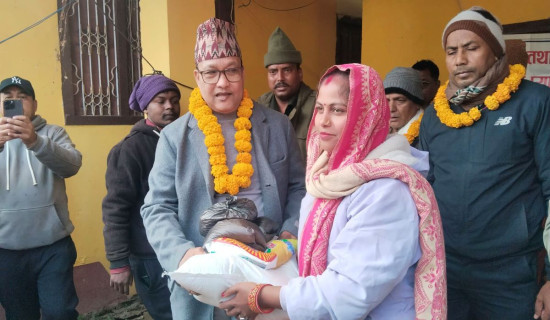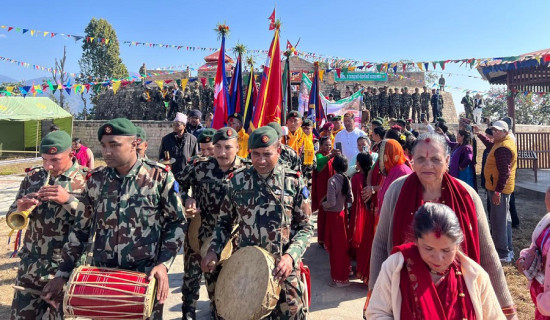- Thursday, 8 January 2026
Communist Parties In Existential Crisis
Different communist factions in Nepal marked the founding day of the Nepal Communist Party (NCP) on April 22 with tall speeches and statements calling for a broader communist unity. However, their actions and behaviour do not at all match with what they say. Despite their tall talks of communist unity, over a dozen of communist parties exist in Nepal and they are inimical to one another. The NCP was founded in 1949 by five young revolutionaries namely Pushpalal Shrestha, Nar Bahadur Karmacharya, Narayan Bilas Joshi, Niranjan Govinda Vaidya and Moti Devi Shrestha in exile with Pushpa Lal as general secretary.
Puspalal was the mastermind behind the formation of the NCP. He is therefore regarded as the father of the communist movement in Nepal. This was the time when the communist movement was vibrant globally. The victory of the Bolsheviks ‘s revolution led by V I Lenin and establishment of the communist system in the Soviet Union (now Russia) inspired the communists and revolutionaries all over the world to join and spearhead the revolutions. The post-World War II period saw a wave of national liberation movements across the world.
Liberation movement
Our neighbour India had attained independence from British colonial rule in 1947. Similarly, Chinese Revolution established People’s Republic of China in 1949. The political changes in both of our two neighbours and also the national liberation movements across the world inspired Nepali youths for democratic change. Nepal was under Rana’s oligarchic rule. People’s civil and political rights had been summarily suppressed during that tyrannical regime. The communist party was founded with the objective of overthrowing the Rana regime and ultimately establishing a socialist system in Nepal in a similar fashion what Mao Zedong did in 1949.
The NCP defined Nepal’s social and economic situation as being feudal and semi-colonial and it aimed to liberate the people from all forms feudal exploitation, discrimination and establish ‘new democracy’ in Nepal. The feudal Rana regime was overthrown but it was replaced by feudal Shah Monarchy. Thus, no fundamental change could be effected in the political front as well as in the people’s life. Communist revolutionaries thought that a new and decisive revolution was needed to bring about a systemic change. According to them, such a decisive revolution was possible only under the banner of the communist party. Despite party’s revolutionary ideas, the communist party was fragile due to weaker organisational base and internal feuds among leaders. The communist party, thus, suffered many ups and downs.
In the wake of KI Sing’s revolt 1952, the communist party was banned for supporting Singh’s revolt but the ban was lifted in 1954. In the parliamentary election held in 1959, the communist party won only four out of total 108 parliamentary seats, which manifests weak organisational and popular base. The party suffered in the absence of maturity and unity in the leadership. When king Mahendra staged a royal coup, the communist party suffered badly not only because of tyrannical suppression but because of some leaders’ hobnobbing with the king, which divided it. The communist party split as one section of the party supported the royal coup while other group led by Pushpa Lal condemned the coup demanding restoration of dissolved parliament.
While split is a strong phenomenon of Nepal’s communist party, attempt of unification is also equally important trend. The CPN-UML was created by unifying several communist parties and CPN-Maoist Centre too is another example of unity among different small parties. Three fundamental trends always exist in Nepali politics. They are rightist, centrist and leftist trends. The royalist, regressive and conservative elements are always grouped in the rightist camp, while Nepali Congress traditionally is a centrist force although it often swings sometime towards right and sometime towards left based on the issues and situation. Despite its stated centrist and social democratic stance in principle, it has vacillated towards far right in the economic policy especially after the 1990 political change.
Politically, NC has gone too left from the time of signing the Comprehensive Peace Agreement with the Maoists in 2006 till the promulgation of the present constitution. The present constitution is left-oriented constitution and the Nepali Congress is the principal architect of the constitution-making. The communist parties mainly the UML and Maoist Centre represent the leftist trend. Similarly, there are three trends within the Nepali communist movement, too. The first trend is the radical one that champions the use of violent method to overthrow the existing system and establish one-party communist regime. The second is the reform and liberal trend that seeks to use peaceful competition or election as a tactical tool to capture power and introduce radical programmes.
People-oriented schemes
The third trend is the one that accepts the multiparty system and liberal democracy through which it seeks to go to power and introduce people-oriented schemes. UML represents the third trend within the communist movement. Maoist Centre falls into second category and this party, too, is slowly following UML’s path. Smaller parties that advocate violent revolution represent the first trend. UML and Maoist Centre are leftist parties and their maximum objective is to achieve democratic socialism something akin to the system in Nordic countries. They no longer follow Karl Marx’s dictum the ‘dictatorship of the proletariats’. Nepal’s communist parties have already abandoned the Marxist way of achieving socialism and communism.
The general trend in the communist parties is to begin with radical and revolutionary slogans and slowly transforming into social democratic model. Even the parties that continue to advocate ‘revolutionary socialism’ will one day end up converting themselves into ‘neo-bourgeoisies’. Presently, UML and Maoist Centre are the two strong moderate communist parties. These parties are vying to secure their space in the parliamentary politics. Given the triangular polarisation of Nepali politics, two strong moderate communist parties will not exist for a long time. So UML and Maoist Centre are in existential crisis as one of them will definitely perish. It bodes well if the leaders of these two parties learn lessons from history and general mood of the leftist voters before it is too late.
(The author is former ambassador and former chief editor of this daily. lamsalyubanath@gmail.com)
















